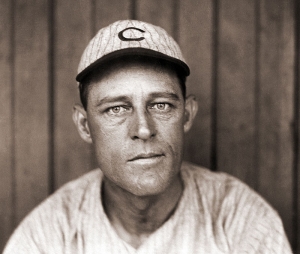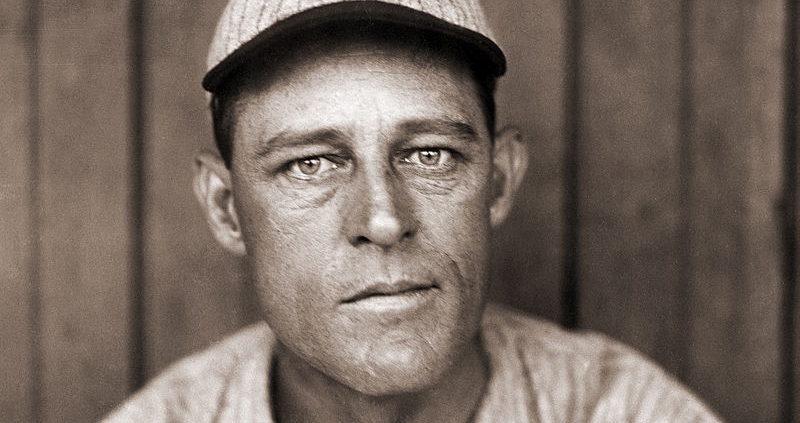Harry Steinfeldt
 Today Harry Steinfeldt is the answer to a oft-heard trivia question: Who was the third baseman in the Cubs’ famous Joe Tinker-to-Johnny Evers-to-Frank Chance infield? In his time, however, the .267 lifetime hitter was considered one of the greatest third basemen in the game. “Harry Steinfeldt, the Cubs third baseman whose glorious fielding kept the dashing Ty Cobb off the base paths in a couple of world’s series, and whose lusty wallops sent many a fellow-Cub scampering across home plate in the last few years, is another who was dubbed unfit by an erring leader in ill-fated Cincinnati,” wrote Alfred H. Spink in 1910. “Harry left the haunts of the Reds, jumped in and completed Frank Chance’s sterling infield, and still holds his court there, a veritable terror to seekers of base hits and stolen cushions.”
Today Harry Steinfeldt is the answer to a oft-heard trivia question: Who was the third baseman in the Cubs’ famous Joe Tinker-to-Johnny Evers-to-Frank Chance infield? In his time, however, the .267 lifetime hitter was considered one of the greatest third basemen in the game. “Harry Steinfeldt, the Cubs third baseman whose glorious fielding kept the dashing Ty Cobb off the base paths in a couple of world’s series, and whose lusty wallops sent many a fellow-Cub scampering across home plate in the last few years, is another who was dubbed unfit by an erring leader in ill-fated Cincinnati,” wrote Alfred H. Spink in 1910. “Harry left the haunts of the Reds, jumped in and completed Frank Chance’s sterling infield, and still holds his court there, a veritable terror to seekers of base hits and stolen cushions.”
The son of a German immigrant, Henry M. Steinfeldt was born on September 29, 1877, in St. Louis. When Harry was five years old his family moved to Ft. Worth, Texas. In the early 1890s he reportedly toured the state with Al Field’s Minstrels, playing baseball for one of the towns in which the show was billed. Harry made his professional debut in 1895 as a utility infielder with Ft. Worth of the Texas League. He split the next season between Ft. Worth and Galveston, batting .320 and leading all Texas League second basemen with a .989 fielding percentage. That fall Steinfeldt was drafted by Detroit of the Western League. When the Detroit president discovered that the Texas League club had mistakenly written his name as “Steinhoff” on its reserve list, he called off negotiations and signed Harry without any compensation to Galveston. Justice was served the following year, however, when the National League’s Cincinnati Reds drafted both Steinfeldt and pitcher Noodles Hahn from Detroit.
Cincinnati’s star-studded 1898 infield featured Bid McPhee at second base, Tommy Corcoran at shortstop, and Charlie Irwin at third. For several seasons Steinfeldt filled in when those veterans were injured or sick, establishing himself as the best utility man in club history. Manager Buck Ewing was especially impressed with Harry’s quick release: “He throws better than anyone I ever saw. I don’t mean his terrific throwing, particularly, but the rapidity with which he gets a ball started on a journey. The ball is hardly in his hands before he has it sailing through the air.” Taking over as the Reds regular third baseman in 1901 when Irwin was released in midseason, Steinfeldt became known as the first and possibly only third baseman to wear shin guards. His breakout season was 1903, when he batted .312 and led the National League with 32 doubles. At the age of 25, Steiney was a star.
But a leg injury hampered Steinfeldt the following year, and in 1905 he reportedly became dissatisfied and didn’t give the club his best efforts, prompting one commentator to state that he was “all in as a player.” His friend and teammate Al Bridwell recalled a funny thing that happened near the end of that season. “Steinfeldt came over to me one day and said, ‘Kid, you’re going to be the regular third baseman pretty soon, maybe starting today,’” said Bridwell. “‘What do you mean?’ I asked him. ‘Wait and see,’ he says, ‘something might happen. You never can tell in this game.’ Well, about the second or third inning that day a foul ball went up off third base, near the railing, and Steiney ran over to catch it. As he did, he tumbled over the railing and hurt himself and had to leave the game. So they sent me out to play third in his place, and I finished the season at that position. That winter Steiney was traded to the Chicago Cubs for Hans Lobert [and Jake Weimer], and he became the third baseman in the famous Tinker-Evers-Chance infield. So you can figure what you want to out of that.”
The trade proved to be the turning point in Steinfeldt’s career. Earlier that off-season the Cubs had sent their regular third baseman, Doc Casey, to Brooklyn in the blockbuster trade for Jimmy Sheckard. “The addition of these two stars [Steinfeldt and Sheckard] made the Cubs the greatest baseball machine in the country,” wrote one reporter. Putting up the best numbers of his career, Steinfeldt batted .327, second in the National League, and led the NL with 176 hits and 83 RBIs. He also led NL third basemen with a .954 fielding percentage, a statistic in which he led the league in three of his five seasons in Chicago, earning a reputation as the greatest fielding third sacker in the game. Steinfeldt followed up his career year in 1906 with a spectacular performance in the 1907 World Series, batting .471 to lead all players as the Cubs swept the Detroit Tigers in four straight.
The Cubs rewarded Steinfeldt’s efforts with a three-year contract, but from that point on his performance started to slip. In 1908 he batted a career-low .241, and though he rebounded somewhat to hit .252 in both 1909 and 1910, he tailed off significantly toward the end of the latter season. Steinfeldt’s slump continued during the 1910 World Series, when he managed only two hits in 20 at-bats. At this point in his career, few if any of his hits were of the infield variety, as is evident from this anecdote from 1909 that Spink related to illustrate the fielding prowess of Honus Wagner: “Steinfeldt hit the ball along the third-base line past Jap Barbeau, so fast that that player didn’t get a look at it. But Wagner made a couple of jack-rabbit jumps, speared the ball with his right hand way back of third, and, without straightening up, whizzed it to first, turning back the runner by a step.”
Despite his poor showing in 1910, Harry remained at home in the Cincinnati suburb of Bellevue, Kentucky, while the rest of his teammates reported for spring training the following season. He had married a woman from Bellevue when he was playing for the Reds, and at her behest he was holding out for another three-year contract. The Cubs asked for waivers on Steinfeldt, but the waivers were recalled when both Boston and Cincinnati claimed him. Shortly thereafter Harry decided to report, but by then Chance was so impressed with Harry’s replacements, rookie Jim Doyle and utilityman Heinie Zimmerman, that the Cubs made a second attempt at waivers, and this time they were obtained. Before the start of the season Chicago sold Steinfeldt to St. Paul of the American Association. “That winds it all up,” Harry told a reporter. “Don’t ever think I’m going to play ball in St. Paul.”
Steinfeldt went home to Cincinnati and worked for his father-in-law’s bread-pan factory, but before long he joined the St. Paul team. After a good start in the American Association, he received another shot at the National League when St. Paul traded him to the Boston Rustlers for a pair of young players and cash. For 19 games Steiney was Boston’s regular third baseman, now and again showing flashes of his former brilliance, but in mid-July he came down with a serious illness. Mrs. Steinfeldt came to Boston and took him home to Bellevue, where it was feared that he might be developing typhoid fever. According to an August report, Steinfeldt was hospitalized in Cincinnati, suffering from a “complete nervous breakdown,” and was “kept as quiet as possible” by his physicians. The report went on to state that Mrs. Steinfeldt “is very much opposed to his playing ball any more and will urge him to retire permanently as soon as he is out of the hospital.”
But the lure of the baking supplies’ business was insufficient to prevent Harry’s return to the diamond. In February 1912 he signed to manage the Cincinnati team in the new United States League, but when that circuit folded he accepted an invitation to try out for the St. Louis Cardinals. Drawing his unconditional release before the season opened, Steinfeldt, in the words of one poetic commentator, “then tried the minors, but his heart was broken, and he could not reconcile himself to Father Time’s claim.” After being let go by Louisville, Chattanooga, and Meridian, he “went to his home and to bed with an illness that ended his life on August 17, 1914.” The death certificate of the 37-year-old indicates that he died of a cerebral hemorrhage.
Note: An earlier version of this biography appeared in Tom Simon, ed., Deadball Stars of the National League (Washington, D.C.: Brassey’s, Inc., 2004).
Sources
In preparing this biography, the author relied primarily on Harry Steinfeldt’s file at the National Baseball Hall of Fame Library in Cooperstown, New York.
Full Name
Harry M. Steinfeldt
Born
September 29, 1877 at St. Louis, MO (USA)
Died
August 17, 1914 at Bellevue, KY (USA)
If you can help us improve this player’s biography, contact us.


